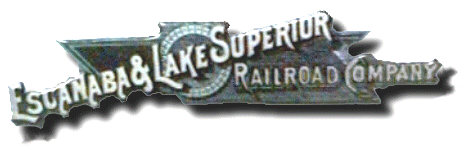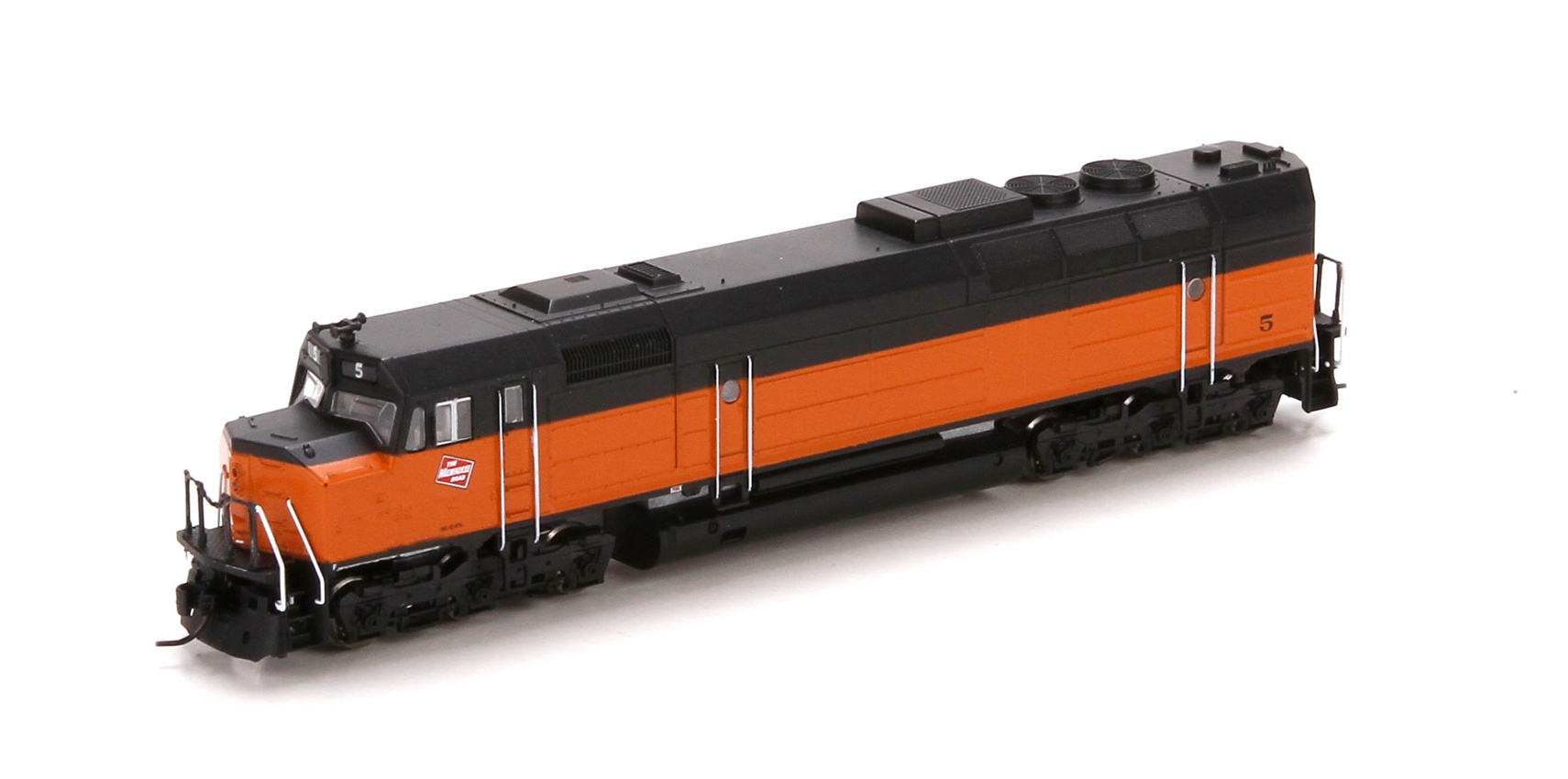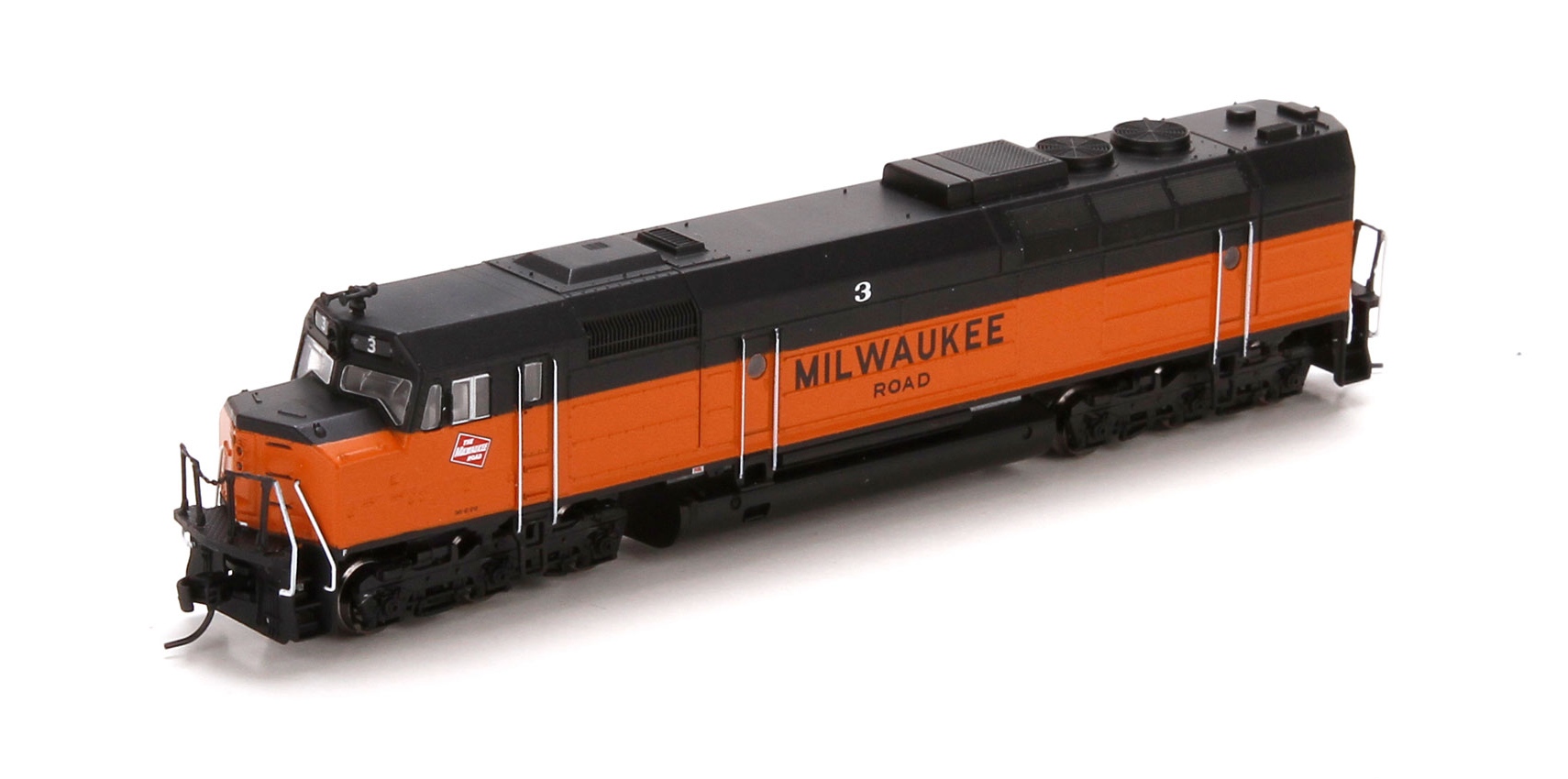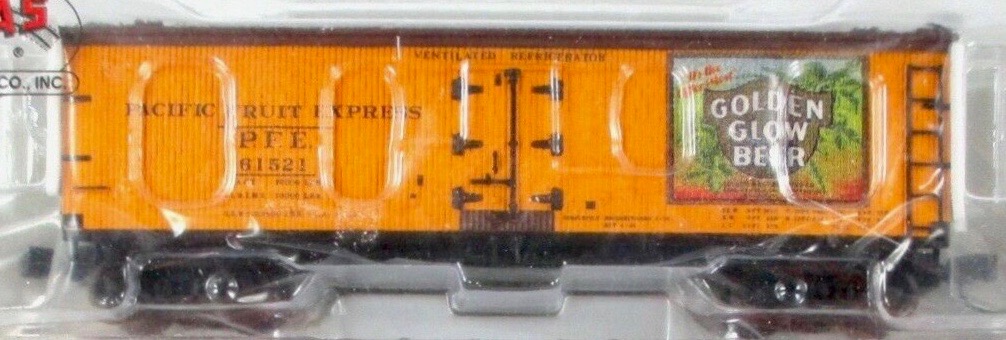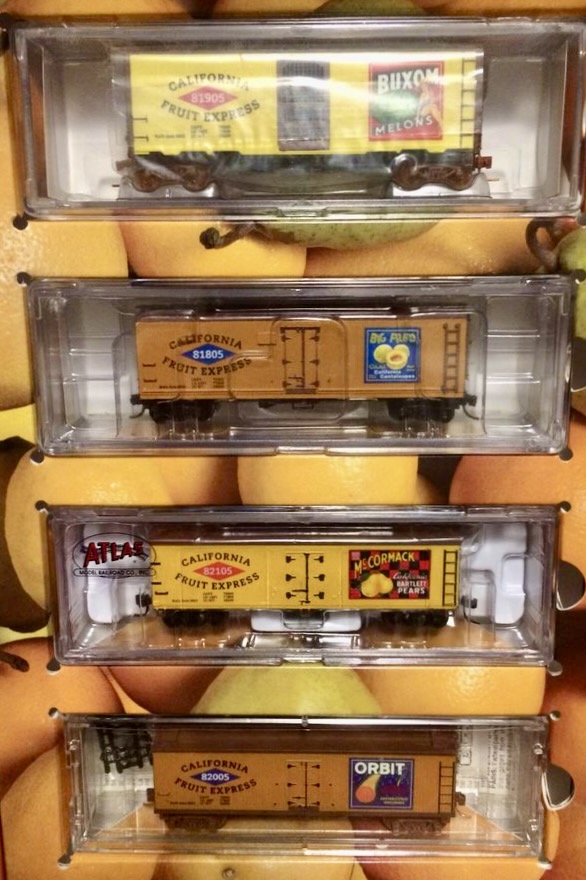Model Information: This MDC Roundhouse body style models a 50 Foot Pullman Standard (PS) Boxcar with a single sliding door, Rib Sides, peaked ends, and no roofwalk. The molds were acquired by Athearn/Horizon Hobbies in 2004.
The 2021 release of this model included these features: See through metal roof walk, Scale profile brake wheel, Detailed under frame, Roller bearing or Bettendorf trucks, Fully-assembled and ready-to-run out of the box, Accurately painted and printed, Highly detailed, injection molded body, Machined metal wheels, Screw mounted trucks, McHenry knuckle couplers, Weighted for trouble free operation, Clear plastic jewel box for convenient storage, Operates on Code 55 and 80 rail, Minimum radius: 9 ¾”
The 2021 release of this model included these features: See through metal roof walk, Scale profile brake wheel, Detailed under frame, Roller bearing or Bettendorf trucks, Fully-assembled and ready-to-run out of the box, Accurately painted and printed, Highly detailed, injection molded body, Machined metal wheels, Screw mounted trucks, McHenry knuckle couplers, Weighted for trouble free operation, Clear plastic jewel box for convenient storage, Operates on Code 55 and 80 rail, Minimum radius: 9 ¾”
Prototype History: The Pullman Standard or PS-1 design was one of the most popular and was widely used by North American railroads. These boxcars were built beginning in 1947 and share the same basic design, with certain elements such as door size, door style or roof type varying among the different railroads and production years. When production of these cars ceased in 1963, over 100,000 had been produced.
The original PS-1 measured 40 foot in length, but Pullman Standard also offered 50′ and later 60′ boxcars – also with the PS-1 designation.
The original PS-1 measured 40 foot in length, but Pullman Standard also offered 50′ and later 60′ boxcars – also with the PS-1 designation.
Road Name History:
The E&LS was built in 1898 to link the harbor of Escanaba to a connection with the Milwaukee Road in Channing in Michigan’s Upper Peninsula. The mileage during this first period was about 68.
The E&LS dieselized with an all Baldwin fleet and the road would remain all-Baldwin until the expansion in 1980. That year, Milwaukee Road was in the process of spinning off lines left and right so the Escanaba & Lake Superior leased routes from Channing northwest to Ontonogon near the Minnesota border, and from Channing south to Green Bay, Wisconsin giving the system map a lopsided T shape. At this point the mileage was up to 325 miles. Four years later, E&LS bought those lines from Milwaukee Road (which was being sold to Soo at the time.) Secondhand EMD’s were brought in to help the aging fleet of Baldwins. By 1991, half the fleet was EMD and the other half Baldwin. In the last few years, E&LS obtained trackage rights on Canadian National to shorten the route for traffic between Escanaba and Green Bay.
The Baldwin fleet included the two former Delaware & Hudson RF16A shark nose units that had been railfan favorites in the Northeast in the 70s. Both sharks are still on the property but are stored out of sight. In the last couple of decades, E&LS had trouble with people stealing parts such as bells and builder plates from their increasingly rare Baldwins. This has made E&LS hostile to railfans so if you find yourself in this neck of the woods, stay well clear of E&LS property.
The E&LS dieselized with an all Baldwin fleet and the road would remain all-Baldwin until the expansion in 1980. That year, Milwaukee Road was in the process of spinning off lines left and right so the Escanaba & Lake Superior leased routes from Channing northwest to Ontonogon near the Minnesota border, and from Channing south to Green Bay, Wisconsin giving the system map a lopsided T shape. At this point the mileage was up to 325 miles. Four years later, E&LS bought those lines from Milwaukee Road (which was being sold to Soo at the time.) Secondhand EMD’s were brought in to help the aging fleet of Baldwins. By 1991, half the fleet was EMD and the other half Baldwin. In the last few years, E&LS obtained trackage rights on Canadian National to shorten the route for traffic between Escanaba and Green Bay.
The Baldwin fleet included the two former Delaware & Hudson RF16A shark nose units that had been railfan favorites in the Northeast in the 70s. Both sharks are still on the property but are stored out of sight. In the last couple of decades, E&LS had trouble with people stealing parts such as bells and builder plates from their increasingly rare Baldwins. This has made E&LS hostile to railfans so if you find yourself in this neck of the woods, stay well clear of E&LS property.
Brand/Importer Information: Athearn's history began in 1938, when its founder-to-be, Irvin Athearn, started an elaborate O scale layout in his mother's house. After placing an ad selling the layout, and receiving much response to it, Irv decided that selling model railroads would be a good living. He sold train products out of his mother's house through most of the 1940s. After becoming a full-time retailer in 1946, Irv opened a separate facility in Hawthorne, California in 1948, and that same year he branched into HO scale models for the first time.
Athearn acquired the Globe Models product line and improved upon it, introducing a comprehensive array of locomotive, passenger and freight car models. Improvements included all-wheel drive and electrical contact. One innovation was the "Hi-Fi" drive mechanism, employing small rubber bands to transfer motion from the motor spindle to the axles. Another was the double-ended ring magnet motor, which permitted easy connection to all-wheel-drive assemblies. Athearn was also able to incorporate flywheels into double-ended drives.
The company produced a model of the Boston & Maine P4 class Pacific steam locomotive which incorporated a cast zinc alloy base and thermoplastic resin superstructure. It had a worm drive and all power pickup was through the bipolar trucks that carried the tender. This item was discontinued after the Wilson motor was no longer available, and was not redesigned for a more technologically advanced motor.
Athearn's car fleet included shorter-than-scale interpretations of passenger cars of Southern Pacific and Atchison, Topeka & Santa Fe Railroad prototypes. The company also offered a variety of scale-length freight cars with sprung and equalized trucks. The cars could be obtained in simple kit form, or ready-to-run in windowed display boxes. The comprehensive scope of the product line contributed to the popularity of HO as a model railroad scale, due to the ready availability of items and their low cost.
Irv Athearn died in 1991. New owners took control in 1994, but continued to follow Athearn's commitment to high-quality products at reasonable prices. Athearn was bought in 2004 by Horizon Hobby. Athearn was then moved from its facility in Compton to a new facility in Carson, California. In mid-2009, all remaining US production was moved to China and warehousing moved to parent Horizon Hobby. Sales and product development was relocated to a smaller facility in Long Beach, California.
Read more on Wikipedia and Athearn website.
Athearn acquired the Globe Models product line and improved upon it, introducing a comprehensive array of locomotive, passenger and freight car models. Improvements included all-wheel drive and electrical contact. One innovation was the "Hi-Fi" drive mechanism, employing small rubber bands to transfer motion from the motor spindle to the axles. Another was the double-ended ring magnet motor, which permitted easy connection to all-wheel-drive assemblies. Athearn was also able to incorporate flywheels into double-ended drives.
The company produced a model of the Boston & Maine P4 class Pacific steam locomotive which incorporated a cast zinc alloy base and thermoplastic resin superstructure. It had a worm drive and all power pickup was through the bipolar trucks that carried the tender. This item was discontinued after the Wilson motor was no longer available, and was not redesigned for a more technologically advanced motor.
Athearn's car fleet included shorter-than-scale interpretations of passenger cars of Southern Pacific and Atchison, Topeka & Santa Fe Railroad prototypes. The company also offered a variety of scale-length freight cars with sprung and equalized trucks. The cars could be obtained in simple kit form, or ready-to-run in windowed display boxes. The comprehensive scope of the product line contributed to the popularity of HO as a model railroad scale, due to the ready availability of items and their low cost.
Irv Athearn died in 1991. New owners took control in 1994, but continued to follow Athearn's commitment to high-quality products at reasonable prices. Athearn was bought in 2004 by Horizon Hobby. Athearn was then moved from its facility in Compton to a new facility in Carson, California. In mid-2009, all remaining US production was moved to China and warehousing moved to parent Horizon Hobby. Sales and product development was relocated to a smaller facility in Long Beach, California.
Read more on Wikipedia and Athearn website.
Item created by: CNW400 on 2020-10-01 23:12:10
If you see errors or missing data in this entry, please feel free to log in and edit it. Anyone with a Gmail account can log in instantly.
If you see errors or missing data in this entry, please feel free to log in and edit it. Anyone with a Gmail account can log in instantly.




